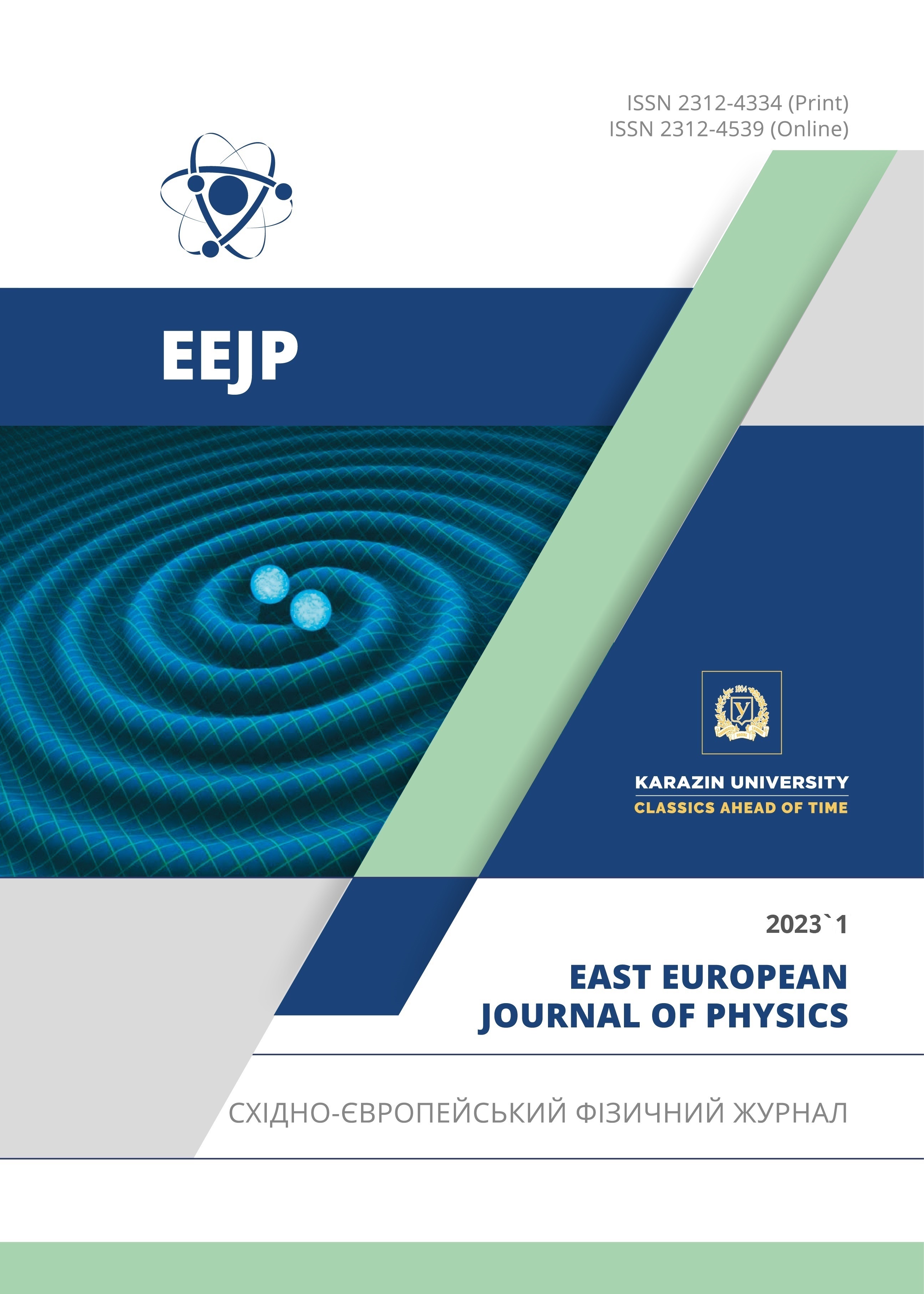Investigation of the Impact of Glass Waste in Reactive Powder Concrete on Attenuation Properties for Bremsstrahlung Ray
Abstract
Reactive Powder Concrete (RPC) is one of the most advanced recent high compressive strength concrete. This work explored the effects of using glass waste as a fractional replacement for fine aggregate in reactive powder concrete at levels of 0%, 25%, 50%, and 100%. Linear and mass attenuation coefficients have been calculated as a function of the sample's thickness and bremsstrahlung energy. These coefficients were obtained using energy selective scintillation response to bremsstrahlung having an energy ranging from (0.1-1.1) MeV. In addition, the half-value thickness of the samples prepared has been investigated. It was found that there is a reversal association between the attenuation coefficient and the energy of the bremsstrahlung ray.
The results showed that, with the exception of the specimen with a partial replacement of 25% glass waste, adding fine aggregate in part by glass waste had a negative impact on the reactive powder concrete's attenuation properties. That means the sample’s density can be improved with the glass waste content ratio to 25%. Also, the bremsstrahlung radiation shielding capabilities of reactive powder concrete can be enhanced using glass waste of not more than 25%.
Downloads
References
J.E. Martin, Physics for Radiation Protection. 3rd ed. (WILEY-VCH Verlag GmbH & Co. KGaA, Weinheim, 2006), pp. 311.
B. Badarloo, P. Lehner, and R.B. Doost, “Mechanical Properties and Gamma Radiation Transmission Rate of Heavyweight Concrete Containing Barite Aggregates”, Materials, 15, 2173 (2022). https://doi.org/10.3390/ma15062173
S.H. Al-Tersawy, R.A. El-Sadany, H.E. Sallam, “Experimental gamma-ray attenuation and theoretical optimization of barite concrete mixtures with nanomaterials against neutrons and gamma rays”, Constr. Build. Mater. 289, 123190 (2021). https://doi.org/10.1016/j.conbuildmat.2021.123190
W. Luo, H. Wang, X. Li, X. Wang, Z. Wu, Y. Zhang, X. Lian, and X. Li, “Mechanical Properties of Reactive Powder Concrete with Coal Gangue as Sand, Replacement”, Materials, 15, 1807 (2022). https://doi.org/10.3390/ma15051807
N.M. Aowd, and H.S. Hussain, “Absorption coefficient measurement of bremsstrahlung radiation in nano composite”, Eng. & Tech. Journal, 33(7), 1258 (2015). https://etj.uotechnology.edu.iq/article_116691.html
C. Laxman, and R. Dayanand, “Mass attenuation coefficient measurements in soil sample”, Res. J. Chem. Sci. 2(5), 17 (2012). http://www.isca.in/rjcs/Archives/v2/i5/3.ISCA-RJCS-2012-035_Done.pdf
S.D. Mohammed, W.Z. Majeed, N.B. Naji, and N.M. Fawzi, “Investigating the influence of gamma ray energies and steel fiber on attenuation properties of reactive powder concrete”, Nucl. Sci. Tech. 28(10), 153 (2017). https://doi.org/10.1007/s41365-017-0305-9
B.M. Chandrika, H.C. Manjunatha, K.N. Sridhar, and H. Chikka, “Bremsstrahlung shielding parameters in polymer concretes”, Radiat. Eff. Def. Solids. 173(5-6), 414 (2018). https://doi.org/10.1080/10420150.2018.1462363
R. Ramli, F.M. Idris, M.F. Yapandi, J.Md. Saad, and S.A. Biyamin, “Investigation on different compositions of flyash concrete on gamma and neutron radiation”, Mater. Sci. Eng. 555, 012013 (2019). https://doi.org/10.1088/1757-899X/555/1/012013
I.K. Alhagaish, and V.K. Sakharov, “Photon radiation fields characteristics in concrete for photon sources with energies from 10 to 50MeV”, Inter. J. Sci. Tech. Res. 9(4), 2280 (2020). https://www.ijstr.org/final-print/apr2020/Photon-Radiation-Fields-Characteristics-In-Concrete-For-Photon-Sources-With-Energies-From-10-To-50-Mev.pdf
N.B. Naji, Sh.D. Mohammed, W.Z. Majeed, N.M. Fawzi, “Irradiation duration effect of gamma ray on the compressive strength of reactive powderconcrete”, in: International Conference on Geotechnical engineering, (Trans Tech Publications Ltd, Switzerland, 2020), pp. 15-21.
A.M. Abdel-Latif, M.I. Sayyed, H.O. Tekin, and M.M. Kassab, “Optimizing the shielding properties of strength-enhanced concrete containing marble”, Pape. Phys. 12, 120005 (2020). https://doi.org/10.4279/pip.120005
M.D. Desta, M. Tessema, V.K. Mittal, and D.D. Amamo, “Experimental determination of linear attenuation coefficient of gamma ray in Zinc foil at different energies”, J. Medi. Phys. Appl. Sci. 5(1-6), 1-8 (2020). https://doi.org/10.36648/2574-285X.5.1.6
D. Rezaei-Ochbelagh, S. Azimkhani, and H.G. Mosavinejad, “Shielding and strength tests of silica fume concrete”, Ann. Nucl. Energy, 45, 150–154 (2012). http://dx.doi.org/10.1016/j.anucene.2012.02.006
K. Janković, S. Stanković, D. Bojović, M. Stojanović, and L. Antić, “The influence of nano-silica and barite aggregate on properties of ultra-high-performance concrete”, Constr. Build. Mater. 126, 147 (2016). http://dx.doi.org/10.1016%2Fj.conbuildmat.2016.09.026
M.M. Tufekci, and A. Gokce, “Development of heavyweight high-performance fiber reinforced cementitious composites (HPFRCC)”, Part 1: mechanical properties, Constr. Build. Mater. 148, 559 (2017). https://doi.org/10.1016/j.conbuildmat.2017.05.009
Z. Wu, C. Shi, and W. He, “Comparative study on flexural properties of ultra-high-performance concrete with supplementary cementitious materials under different curing regimes”, Constr. Build. Mater. 136, 307 (2017). https://doi.org/10.1016/j.conbuildmat.2017.01.052
W.Z. Majeed, N.B. Naji, S.D. Mohammed, “Attenuation coefficient of reactive powder concrete using different energies”, Int. J. Adv. Res. 4(7), 72 (2016). http://dx.doi.org/10.21474/IJAR01/1161
Iraq Standard Specification. IQS 5:84. Standard specification for Portland cement. Iraq: C.O.S.Q.C; 1984.
Iraq Standard Specification. IQS 45-93. Aggregate from natural sources for concrete and building construction. Iraq: C.O.S.Q.C; 1993.
American Society for Testing and Materials. ASTM C1240-03. Standard specification for use of silica fume as a mineral admixture in hydraulic cement concrete, mortar and grout. USA: ASTM; 2003.
Copyright (c) 2023 Wasan Z. Majeed, Rawaa K. Aboud, Nesreen B. Naji, Shatha D. Mohammed

This work is licensed under a Creative Commons Attribution 4.0 International License.
Authors who publish with this journal agree to the following terms:
- Authors retain copyright and grant the journal right of first publication with the work simultaneously licensed under a Creative Commons Attribution License that allows others to share the work with an acknowledgment of the work's authorship and initial publication in this journal.
- Authors are able to enter into separate, additional contractual arrangements for the non-exclusive distribution of the journal's published version of the work (e.g., post it to an institutional repository or publish it in a book), with an acknowledgment of its initial publication in this journal.
- Authors are permitted and encouraged to post their work online (e.g., in institutional repositories or on their website) prior to and during the submission process, as it can lead to productive exchanges, as well as earlier and greater citation of published work (See The Effect of Open Access).








